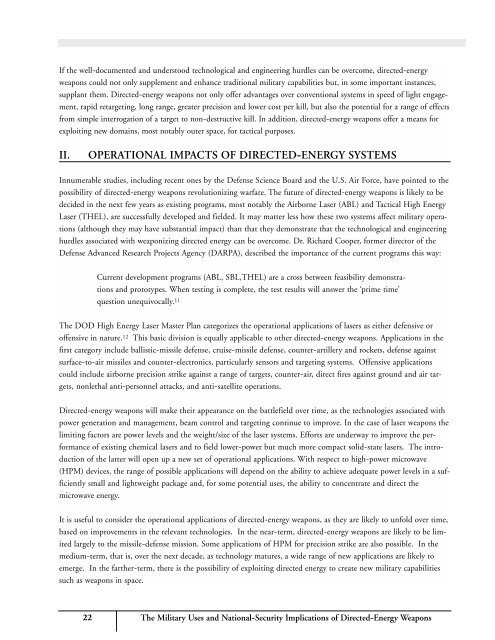directed-energy-weapons
directed-energy-weapons
directed-energy-weapons
Create successful ePaper yourself
Turn your PDF publications into a flip-book with our unique Google optimized e-Paper software.
If the well-documented and understood technological and engineering hurdles can be overcome, <strong>directed</strong>-<strong>energy</strong><strong>weapons</strong> could not only supplement and enhance traditional military capabilities but, in some important instances,supplant them. Directed-<strong>energy</strong> <strong>weapons</strong> not only offer advantages over conventional systems in speed of light engagement,rapid retargeting, long range, greater precision and lower cost per kill, but also the potential for a range of effectsfrom simple interrogation of a target to non-destructive kill. In addition, <strong>directed</strong>-<strong>energy</strong> <strong>weapons</strong> offer a means forexploiting new domains, most notably outer space, for tactical purposes.II.OPERATIONAL IMPACTS OF DIRECTED-ENERGY SYSTEMSInnumerable studies, including recent ones by the Defense Science Board and the U.S. Air Force, have pointed to thepossibility of <strong>directed</strong>-<strong>energy</strong> <strong>weapons</strong> revolutionizing warfare. The future of <strong>directed</strong>-<strong>energy</strong> <strong>weapons</strong> is likely to bedecided in the next few years as existing programs, most notably the Airborne Laser (ABL) and Tactical High EnergyLaser (THEL), are successfully developed and fielded. It may matter less how these two systems affect military operations(although they may have substantial impact) than that they demonstrate that the technological and engineeringhurdles associated with weaponizing <strong>directed</strong> <strong>energy</strong> can be overcome. Dr. Richard Cooper, former director of theDefense Advanced Research Projects Agency (DARPA), described the importance of the current programs this way:Current development programs (ABL, SBL,THEL) are a cross between feasibility demonstrationsand prototypes. When testing is complete, the test results will answer the ‘prime time’question unequivocally. 11The DOD High Energy Laser Master Plan categorizes the operational applications of lasers as either defensive oroffensive in nature. 12 This basic division is equally applicable to other <strong>directed</strong>-<strong>energy</strong> <strong>weapons</strong>. Applications in thefirst category include ballistic-missile defense, cruise-missile defense, counter-artillery and rockets, defense againstsurface-to-air missiles and counter-electronics, particularly sensors and targeting systems. Offensive applicationscould include airborne precision strike against a range of targets, counter-air, direct fires against ground and air targets,nonlethal anti-personnel attacks, and anti-satellite operations.Directed-<strong>energy</strong> <strong>weapons</strong> will make their appearance on the battlefield over time, as the technologies associated withpower generation and management, beam control and targeting continue to improve. In the case of laser <strong>weapons</strong> thelimiting factors are power levels and the weight/size of the laser systems. Efforts are underway to improve the performanceof existing chemical lasers and to field lower-power but much more compact solid-state lasers. The introductionof the latter will open up a new set of operational applications. With respect to high-power microwave(HPM) devices, the range of possible applications will depend on the ability to achieve adequate power levels in a sufficientlysmall and lightweight package and, for some potential uses, the ability to concentrate and direct themicrowave <strong>energy</strong>.It is useful to consider the operational applications of <strong>directed</strong>-<strong>energy</strong> <strong>weapons</strong>, as they are likely to unfold over time,based on improvements in the relevant technologies. In the near-term, <strong>directed</strong>-<strong>energy</strong> <strong>weapons</strong> are likely to be limitedlargely to the missile-defense mission. Some applications of HPM for precision strike are also possible. In themedium-term, that is, over the next decade, as technology matures, a wide range of new applications are likely toemerge. In the farther-term, there is the possibility of exploiting <strong>directed</strong> <strong>energy</strong> to create new military capabilitiessuch as <strong>weapons</strong> in space.22 The Military Uses and National-Security Implications of Directed-Energy Weapons


